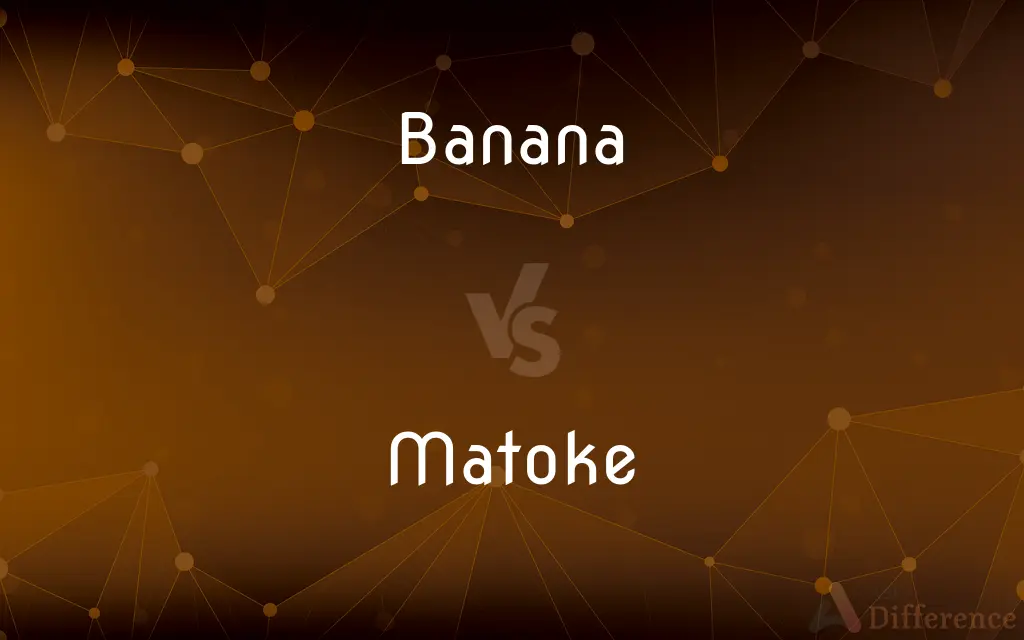Banana vs. Matoke — What's the Difference?
By Fiza Rafique & Urooj Arif — Updated on March 25, 2024
Bananas are widely consumed fresh fruits, while matoke refers to a specific type of banana cooked as a staple food in East Africa.

Difference Between Banana and Matoke
Table of Contents
ADVERTISEMENT
Key Differences
Bananas are a globally popular fruit, known for their sweet taste and soft texture, often eaten fresh or used in desserts and smoothies. Matoke, on the other hand, is a variety of banana that is green, firmer, and used primarily for cooking, especially in East African cuisine where it's a staple food, often steamed and mashed.
While bananas can be consumed raw when ripe, matoke bananas require cooking to become palatable, typically through boiling, steaming, or stewing. This preparation method transforms matoke into a dish similar in consistency to mashed potatoes, which is then served with sauces or meat dishes.
Bananas are versatile in culinary uses, appearing in everything from breakfast dishes to baking recipes, owing to their sweetness and moisture content. Matoke, however, is primarily used in savory dishes, playing a role similar to that of potatoes or plantains in other cultures, highlighting its versatility in main courses.
The nutritional profiles of bananas and matoke are similar, providing essential vitamins and minerals, but matoke's preparation methods and consumption as a cooked staple mean it's often eaten in larger quantities, making it a more significant source of carbohydrates in the diet.
Bananas are grown in many parts of the world and are known for their yellow peel and sweet taste when ripe, making them a popular snack and ingredient worldwide. Matoke bananas are particularly associated with Uganda and other parts of East Africa, where they are a key ingredient in the region's cuisine, reflecting cultural preferences and agricultural practices.
ADVERTISEMENT
Comparison Chart
Type
Fruit, often eaten raw.
Cooking banana, eaten cooked.
Taste
Sweet when ripe.
Starchy, requires cooking to eat.
Culinary Uses
Fresh, desserts, smoothies.
Savory dishes, steamed or boiled.
Nutritional Content
High in potassium, vitamins, and fiber.
Similar, but consumed in cooked form.
Cultural Significance
Global, versatile in many cuisines.
Central to East African cuisine, especially Uganda.
Compare with Definitions
Banana
Provides a quick source of energy due to its natural sugars.
Athletes often eat bananas for a quick energy boost.
Matoke
A variety of green banana used primarily for cooking in East Africa.
She peeled the matoke for tonight's dinner.
Banana
Recognizable by its distinctive yellow peel when ripe.
The bunch of bananas turned yellow, signaling they were ready to eat.
Matoke
Often steamed, boiled, or stewed until soft.
The matoke was steamed in banana leaves for added flavor.
Banana
A sweet, yellow fruit when ripe, enjoyed worldwide.
She added a ripe banana to her morning smoothie.
Matoke
Served mashed with savory sauces or meat.
Matoke was the main dish, accompanied by a spicy peanut sauce.
Banana
Cultivated in tropical and subtropical regions around the world.
The banana plantation provided much of the local employment.
Matoke
A staple food in Uganda and parts of East Africa.
In Uganda, matoke is considered a national dish.
Banana
Eaten raw, used in baking, smoothies, and desserts.
He baked banana bread with overripe bananas.
Matoke
Not sweet, but starchy, making it suitable for hearty meals.
The matoke provided a filling base for the vegetable stew.
Banana
A banana is an elongated, edible fruit – botanically a berry – produced by several kinds of large herbaceous flowering plants in the genus Musa. In some countries, bananas used for cooking may be called "plantains", distinguishing them from dessert bananas.
Matoke
Matoke, locally also known as matooke, amatooke in Buganda (Central Uganda), ekitookye in southwestern Uganda, ekitooke in western Uganda, ebitooke in northwestern Tanzania, igitoki in Rwanda, and by the cultivar name East African Highland banana, is a starchy triploid banana cultivar originating from the African Great Lakes. The fruit is harvested green, carefully peeled, and then cooked and often mashed or pounded into a meal.
Banana
Any of several treelike plants of the genus Musa, especially M. acuminata, having a terminal crown of large, entire leaves and a hanging cluster of fruits.
Matoke
Mashed boiled bananas or plantains, a staple food in Uganda.
Banana
The elongated, edible fruit of these plants, having a thick yellowish to reddish skin and whitish, pulpy flesh.
Banana
An elongated curved tropical fruit of a banana plant, which grows in bunches and has a creamy flesh and a smooth skin.
Banana
In particular, the sweet, yellow fruit of the Cavendish banana cultivar, which may be eaten raw, as distinct from e.g. a plantain for cooking.
Banana
The tropical tree-like plant which bears clusters of bananas, a plant of the genus Musa (but sometimes also including plants from Ensete), which has large, elongated leaves.
Banana
(uncountable) A yellow colour, like that of a banana's skin.
Banana
A person of East Asian descent, especially an ethnic Chinese from a Western country who does not speak Chinese and only speaks English, considered to have overly assimilated and to be subservient to white authority, an East Asian race traitor.
Banana
(sports) A banana kick.
Banana
(nuclear physics) A banana equivalent dose.
Banana
A catamorphism (from the use of banana brackets in the notation).
Banana
Curved like a banana, especially of a ball in flight.
Banana
A perennial herbaceous plant of almost treelike size (Musa sapientum); also, its edible fruit. See Musa.
Banana
Any of several tropical and subtropical treelike herbs of the genus Musa having a terminal crown of large entire leaves and usually bearing hanging clusters of elongated fruits
Banana
Elongated crescent-shaped yellow fruit with soft sweet flesh
Common Curiosities
Can matoke be eaten raw?
No, matoke is too starchy and hard to be consumed raw; it requires cooking.
How is matoke prepared?
Matoke is peeled, then boiled, steamed, or stewed until soft, often served mashed.
Can bananas be used as a substitute for matoke in recipes?
Bananas are sweeter and softer, making them unsuitable as direct substitutes for matoke in savory dishes.
What is the main difference between banana and matoke?
Bananas are sweet fruits typically eaten raw, while matoke refers to cooking bananas used in savory dishes.
What cultural significance does matoke hold?
In Uganda and parts of East Africa, matoke is not just food but a cultural symbol, deeply embedded in the culinary traditions.
What are some popular dishes made with bananas?
Banana bread, banana smoothies, and fried bananas are popular in various cuisines.
Are bananas and matoke nutritionally similar?
Yes, both provide essential nutrients, though matoke is usually part of more substantial meals.
Where is matoke a staple food?
Matoke is a staple in East Africa, especially Uganda.
How do bananas and matoke contribute to a balanced diet?
Both offer vitamins and minerals; bananas are a quick energy source, while matoke is part of hearty meals.
Is matoke available outside of East Africa?
Yes, matoke can be found in international markets, especially in cities with East African communities.
What are some common matoke dishes?
Matoke is commonly served mashed with groundnut sauce, or stewed with vegetables and meat.
Why are bananas so popular globally?
Their sweet taste, convenience, and nutritional benefits make them a favored choice worldwide.
How does the preparation of matoke reflect East African culinary traditions?
The use of banana leaves in steaming matoke and its combination with local spices and ingredients reflect the culinary heritage and practices of East Africa.
How do the flavors of banana and matoke compare?
Bananas are sweet, especially when ripe, whereas matoke is starchy and bland, requiring cooking to enhance its flavor.
Can bananas be cooked like matoke?
While bananas can be cooked, their sweetness and texture differ significantly from matoke, making them less suited to savory dishes.
Share Your Discovery

Previous Comparison
Spire vs. Steeple
Next Comparison
Ectosymbiosis vs. EndosymbiosisAuthor Spotlight
Written by
Fiza RafiqueFiza Rafique is a skilled content writer at AskDifference.com, where she meticulously refines and enhances written pieces. Drawing from her vast editorial expertise, Fiza ensures clarity, accuracy, and precision in every article. Passionate about language, she continually seeks to elevate the quality of content for readers worldwide.
Co-written by
Urooj ArifUrooj is a skilled content writer at Ask Difference, known for her exceptional ability to simplify complex topics into engaging and informative content. With a passion for research and a flair for clear, concise writing, she consistently delivers articles that resonate with our diverse audience.
















































